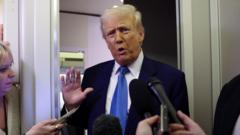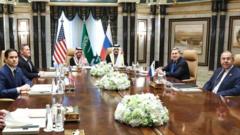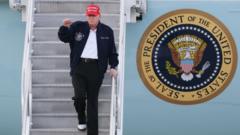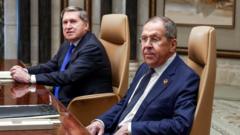The announcement signals an impending shift in international trade relations, particularly affecting nations with higher tariffs and trade barriers against US products.
**Trump Unveils Strategy to Implement New Tariffs on Foreign Exports**
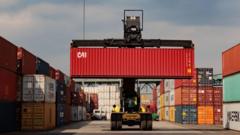
**Trump Unveils Strategy to Implement New Tariffs on Foreign Exports**
US President aims to address perceived trade inequities with reciprocal tariffs tailored for various countries.
On Thursday, President Donald Trump revealed a new directive aimed at imposing tariffs on select countries whose trade practices he deems unfair to American interests. The memo he signed requires his administration to devise customized tariffs for individual countries based on factors such as their current tariff rates, exchange rates, and trade balances. The initiative underscores a broader concern over international trade policies that may disadvantage US exporters, with the European Union being particularly highlighted.
Part of the president's framework includes requesting a plan for "reciprocal trade and tariffs" within a six-month period. Trump’s recently appointed Commerce Secretary Howard Lutnick stated the plan is expected on the desk of the president by April 1. Trump characterized this approach to tariffs as an equitable measure intended to encourage domestic manufacturing and attract more investment to the United States. "If you build your product in the United States, there are no tariffs," he noted, indicating a clear stance that aims to redress perceived imbalances in trade practices.
Countries such as India, Vietnam, and Thailand, which have relatively higher tariffs, appear positioned to be significantly affected by this policy shift, especially as the US remains a vital market for their exports. The announcement comes just before Trump's impending meeting with Indian Prime Minister Narendra Modi, where discussions on mutual tariff adjustments are anticipated. Meanwhile, Thailand and Vietnam have begun reassessing their trade relationships with the United States following the new directive.
In response to these developments, the European Union has reiterated its commitment to a constructive partnership with the US, stating it is ready to safeguard its own interests while seeking further dialogue. Trade experts have expressed skepticism regarding the implications of these proposed tariffs. While historically, the US has favored free trade policies, the new measures represent a stark departure that prioritizes domestic economic concerns but raises the potential for retaliation from affected countries.
The economic ramifications of newly imposed tariffs remain unclear. Weeks before Trump’s announcement, he initiated a substantial 25% import tax on steel and aluminum while increasing tariffs on a variety of Chinese goods. Although Wall Street responded positively to the news, analysts warn of the uncertainty surrounding the long-term effects of escalating tariffs.
Critics, including economists, caution that the tariffs could introduce higher costs for US businesses and consumers. A recent poll shows a prevailing skepticism among the public regarding the economic viability of such tariffs, with only 24% believing they would bolster the economy. As the debate continues, the administration emphasizes a long-term vision of job growth and a strengthened manufacturing base, maintaining that temporary price increases could stabilize over time.
In conclusion, while Trump seeks to address trade disparities through a tactical tariff plan, significant questions linger over the potential impacts on international relations, domestic markets, and consumer prices. The unfolding situation will require careful monitoring as it shapes the future of US trade policy.
Part of the president's framework includes requesting a plan for "reciprocal trade and tariffs" within a six-month period. Trump’s recently appointed Commerce Secretary Howard Lutnick stated the plan is expected on the desk of the president by April 1. Trump characterized this approach to tariffs as an equitable measure intended to encourage domestic manufacturing and attract more investment to the United States. "If you build your product in the United States, there are no tariffs," he noted, indicating a clear stance that aims to redress perceived imbalances in trade practices.
Countries such as India, Vietnam, and Thailand, which have relatively higher tariffs, appear positioned to be significantly affected by this policy shift, especially as the US remains a vital market for their exports. The announcement comes just before Trump's impending meeting with Indian Prime Minister Narendra Modi, where discussions on mutual tariff adjustments are anticipated. Meanwhile, Thailand and Vietnam have begun reassessing their trade relationships with the United States following the new directive.
In response to these developments, the European Union has reiterated its commitment to a constructive partnership with the US, stating it is ready to safeguard its own interests while seeking further dialogue. Trade experts have expressed skepticism regarding the implications of these proposed tariffs. While historically, the US has favored free trade policies, the new measures represent a stark departure that prioritizes domestic economic concerns but raises the potential for retaliation from affected countries.
The economic ramifications of newly imposed tariffs remain unclear. Weeks before Trump’s announcement, he initiated a substantial 25% import tax on steel and aluminum while increasing tariffs on a variety of Chinese goods. Although Wall Street responded positively to the news, analysts warn of the uncertainty surrounding the long-term effects of escalating tariffs.
Critics, including economists, caution that the tariffs could introduce higher costs for US businesses and consumers. A recent poll shows a prevailing skepticism among the public regarding the economic viability of such tariffs, with only 24% believing they would bolster the economy. As the debate continues, the administration emphasizes a long-term vision of job growth and a strengthened manufacturing base, maintaining that temporary price increases could stabilize over time.
In conclusion, while Trump seeks to address trade disparities through a tactical tariff plan, significant questions linger over the potential impacts on international relations, domestic markets, and consumer prices. The unfolding situation will require careful monitoring as it shapes the future of US trade policy.









